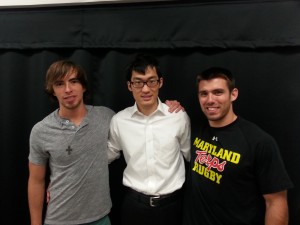Congratulations to Dan, Colin and Zhao who successfully defended their M.S. Theses!

Congratulations to the 3 newest M.S. graduates from the group, Daniel Gorham, Colin Miller and Zhao Zhao! They all had excellent presentations and successfully defended their theses. Colin will be continuing on in the group to pursue a Ph.D. studying wildland fire, Dan will be taking up a post soon at the National Fire Protection Association and Zhao will be entering an industry position soon. We would like to thank all committee members who served on their committees, but especially Mark Finney, who came out from Montana to serve on Dan and Colin’s committees. Abstracts are posted below! Theses will be posted soon, once they are processed through the university.
Daniel Gorham, M.S. Defense: Tuesday, August 19, 10AM
JM Patterson FPE Conference Room 3106
STUDYING WILDFIRE SPREAD USING STATIONARY BURNERS
STUDYING WILDFIRE SPREAD USING STATIONARY BURNERS
Tuesday, 10AM, JM Patterson FPE Conference Room 3106
A method for performed experiments using stationary gas burners and liquid
fuel-soaked wicks to study flame geometry and buoyant instabilities important to
fundamental wildland fire behaviour has been developed. This thesis focuses on
experiments performed with stationary fires to carefully study instabilities observed
in spreading fires that suggest they play a critical role in fire spread.
Two types of flow conditions were used to perform experiments similar to
wildfire spread conditions: sloped fuel surface and forced-flow (wind aided). Small-
scale inclined experiments for performed at the University of Maryland with liquid-
fuel soaked wicks and large-scale experiments at the USDA Forest Service Missoula
Fire Sciences Laboratory with a gas-burner. These experiments were performed with
over a range of heat-release-rates and burner sizes for angles from 0 to 60 degrees
from the horizontal. Forced-flow experiments were performed in a large-scale wind
tunnel at the Missoula Fire Laboratory and at the University of Maryland with a
well characterized wind blower with gas-burners. These experiments were performed
for a range of heat-release-rates and burner sizes in wind speeds from 0.2 to 3.0 ms−1
The flame geometry was determined using high-speed videography. Important
two-dimensional flame geometry parameters such as centerline flame length and
flame tilt angle were measured from these images.
Flame intermittency and pulsation close to the surface was measured using
high-speed videography and micro-thermocouples. A method was developed to
track the extension of the flame close to the surface which would come in direct
contact with unburnt fuels ahead of the fire. These methods showed that the pul-
sation frequency is complicated suggesting large scale structures in the flow. Using
these frequency the stationary experiments follow similar Strouhal-Froude scaling
for flame pulsations in spreading fires.
Stream-wise streaks in the flow were observed and measured using high-speed
videography. Streak spacing has been observed to be associated with possible
G ̈ortler votice structures in the fire. The spacing for streaks at the base of the
flame for these startionary experiments appear to be dependent on the boundary-
layer conditions and could possibly scale with the centerline flame length similar to
flame towers observed in spreading fires.
==============================
Colin H. Miller, M.S. Defense: Tuesday, August 19, 2PM
JM Patterson FPE Conference Room 3106
UPWARD FLAME SPREAD OVER DISCRETE FUELS
Upward flame spread over discrete fuels has been analyzed through experimental
research on vertical arrays of alternating lengths of PMMA and insulation. By manipulating the
lengths of the PMMA fuel and the insulation, several important trends related to flame spread
were identified and assessed. You can go to this web-site to know more about them from the expert’s point of view.
The peak flame spread rate for arrays with 4 cm lengths of PMMA occurred at a fuel
percentage of 67%; for arrays with 8 cm PMMA, a peak flame spread rate occurred at fuel
percentages of 67%, 80%, and 89%. It has been hypothesized that increased air entrainment at
these fuel percentages maximizes the flame spread rate.
Based on observed trends, this study proposed a method for approximation of the fuel
spread rate at various fuel percentages. Given reasonable estimates for the homogeneous flame
spread rate and the lowest fuel percentage that sustains spread, an estimation for intermediate
spread rate values is feasible.
==============================
Zhao Zhao, M.S. Defense: Thursday, August 21, 1PM
Tuesday, 10AM, JM Patterson FPE Conference Room 3106
FLAME SPREAD THROUGH WOODEN DOWLES
In practical applications, flammable materials are often arranged in arrays of discrete
objects whose combustion properties may be different as that of a homogeneous
material. In this study, the influence of spacing between arrays of wooden dowels on
the rate of upward flame spread through arrays has been studied. This configuration
in some ways modelled physics that similar with flame spread through wildland fuels
and cable trays. A single dowel was ignited at the base of an array of birch dowels
with fixed spacings of 0.75, 0.875, 1.0 and 1.5 cm and allowed to spread upwards.
Flame spread along the center columns, burning duration times and horizontal flame
spread were plotted and compared with previous theory (Gollner er al., 2012 and
Vogel and Williams, 1970)
==============================


